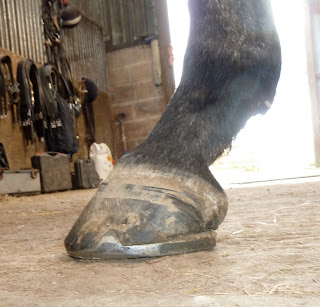This is a post for any of you who tended to agree with
yesterday's post about shoes and scaffolding :-)
For me, its been a week of highs and lows. Rehabbing horses has to be one of the best jobs in the world, but as well as giving you tremendous exhilaration and happiness, it can also bring sleepless nights and intense worry.
It was wonderful to get the
fantastic news about Frankie and Lady over the weekend, both looking a million dollars and back doing what they clearly love.
When I get bad news about ex-rehabs though, its a real kick in the teeth because once they have left here, its almost like waving goodbye to one of my own horses, and I really, REALLY, REALLY want them to carry on doing well and I get really, REALLY, REALLY upset if they don't.
Fortunately, those sorts of set-backs don't happen very often, and its usually something which can be sorted out - a problem with too much grass, or an issue with saddle fit, or an injury which has given the horse a minor setback but which just needs careful handling to get the horse back on track.
What makes me VERY angry, though, is if a rehab horse goes home and is harmed by a trimmer or farrier. The problem is that most owners - quite rightly - feel that they want their horse's feet checked over by a professional every few weeks, but most trimmers and farriers - with the best of intentions - cannot leave well alone.
Very few will turn up, walk and trot the horse, admire its feet, have a cup of tea and then leave. They have a compulsion to fiddle and unfortunately for the horses, they tend to fiddle with knives and rasps in their hands.
Now, none of us are perfect and we all make mistakes - in my case plenty of them - but where I start to see red is if it happens not once but twice, and if the person whose made the mistake refuses to listen to what the horse is telling them - or worst of all, doesn't even bother to find out whether their bright ideas are benefitting or harming the horse.
I always send rehab horses home with a detailed report which covers feeding and exercise, and I used to include a paragraph about trimming as well - usually something terribly diplomatic about the horse likely to need only minimal (if any) trimming, and about the importance of allowing the horse to assert its own medio-lateral balance.
I think though that I will be a bit more radical in future, and send horses home with a final sentence that simply reads:
DO NOT EVEN THINK OF ALLOWING A FARRIER OR TRIMMER NEAR THIS HORSE'S HOOVES WITH ANYTHING SHARPER THAN A STICK OF CELERY.































































